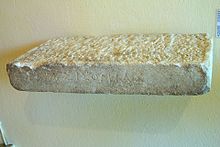User:JLW546/Hestia
| This is the sandbox page where you will draft your initial Wikipedia contribution.
If you're starting a new article, you can develop it here until it's ready to go live. If you're working on improvements to an existing article, copy only one section at a time of the article to this sandbox to work on, and be sure to use an edit summary linking to the article you copied from. Do not copy over the entire article. You can find additional instructions here. Remember to save your work regularly using the "Publish page" button. (It just means 'save'; it will still be in the sandbox.) You can add bold formatting to your additions to differentiate them from existing content. |
Article Draft[edit]
NOTE: Going to add captions/screen reader text to the existing images on the article page
Worship[edit][edit]


The worship of Hestia was centered around the hearth. It was a common practice that she was respected by being offered the first and last libations of wine at feasts. Pausanias writes that the Eleans sacrifice first to Hestia and then to other gods. Xenophon in Cyropaedia wrote that Cyrus the Great sacrificed first to Hestia, then to sovereign Zeus, and then to any other god that the magi suggested.
The accidental or negligent extinction of a domestic hearth-fire represented a failure of domestic and religious care for the family; failure to maintain Hestia's public fire in her temple or shrine was a breach of duty to the broad community. A hearth fire might be deliberately, ritually extinguished at need, and its lighting or relighting should be accompanied by rituals of completion, purification, and renewal, comparable with the rituals and connotations of an eternal flame and of sanctuary lamps. At the level of the polis, the hearths of Greek colonies and their mother cities were allied and sanctified through Hestia's cult. Athenaeus, in the Deipnosophistae, writes that in Naucratis the people dined in the Prytaneion on the natal day of Hestia Prytanitis (Ancient Greek: Ἑστίας Πρυτανίτιδος). NOTE: Going to add citations here
Equivalency[edit][edit]
Her Roman equivalent is Vesta; Vesta has similar functions as a divine personification of Rome's "public", domestic, and colonial hearths, binding Romans together within a form of extended family. The similarity of names between Hestia and Vesta is, however, misleading: "The relationship hestia-histie-Vesta cannot be explained in terms of Indo-European linguistics; borrowings from a third language must also be involved," according to Walter Burkert. Other mythology and religion show similar goddesses or figures. Herodotus equates the Scythian Tabiti with Hestia. And, the Zoroastrian holy fire (atar) of the Sasanians in Adhur Gushnasp was also equated with Hestia by Procopius.

Status and attributes[edit][edit]
Greek tradition described twelve chief gods of Olympus, with Hestia among them. However there are a few instances where Dionysus is presented as one of the twelve and Hestia is missing. This has led scholars to debate her status, with Kenneth Dorter going to far as to claim that, "Since the hearth is immovable Hestia is unable to take part even in the procession of the gods, let alone the other antics of the Olympians." Dorter argues that Her mythographic status as firstborn of Rhea and Cronus seems to justify the tradition in which a small offering is made to Hestia before any sacrifice ("Hestia comes first").
There was a tradition where Hestia received a small offereing before any sacrifice, however this was not univeral among the Greeks. In Odyssey 14, 432–436, the loyal swineherd Eumaeus begins the feast for his master Odysseus by plucking tufts from a boar's head and throwing them into the fire with a prayer addressed to all the powers, then carved the meat into seven equal portions: "one he set aside, lifting up a prayer to the forest nymphs and Hermes, Maia's son."
The ambiguities in Hestia's mythology match her indeterminate attributes, character, and iconography. She is identified with the hearth as a physical object, and the abstractions of community and domesticity, but portrayals of her are rare and seldom secure. In classical Greek art, she is occasionally depicted as a woman, simply and modestly cloaked in a head veil. At times, it shows her with a staff in hand or by a large fire. Her associated sacrificial animal was a domestic pig.
NOTE: going to reword this section for more simple, direct sentences. Also going to confirm there is sufficient citations.
In pop culture[edit][edit]
Hestia appears in Rick Riordian's Percy Jackson and the Olympians book series as a calm, approachable supporting character.[1] In the TV shows Xena: Warrior Princess and Hercules: The Legendary Journeys there is a Cave of Hestia that is attended to by a group of Hestial Virgins.[2]
References[edit]
- "Cave of Hestia". Legendary Journeys. Retrieved 2021-05-22.
- "Hestia". Riordan Wiki. Retrieved 2021-05-22.
- ^ "Hestia". Riordan Wiki. Retrieved 2021-05-22.
- ^ "Cave of Hestia". Legendary Journeys. Retrieved 2021-05-22.
